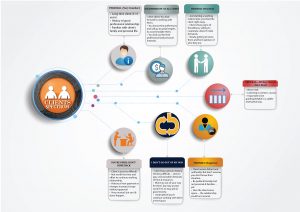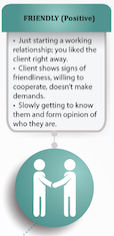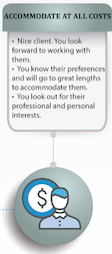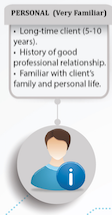Customer Service for Positive Clients
By Claudia Cesarotti | November 11, 2018
Customer service for writers… it’s not impossible to master. In the introductory installment of this series, I explained why customer service matters so much, and promised to walk you through successfully dealing with the seven possible types of clients. Here, we’re going to tackle customer service for the sorts of clients we all hope make up the majority of our business: positive clients.
I’ve previously noted that all clients start out as “neutral” clients. You don’t necessarily know right off the bat how your relationship with them is going to go, or how far down the spectrum your client will fall. I’ve referenced my spectrum of clients before, and I’ve included it here so that you can see for yourself what I mean.

Your spectrum of potential client relationships as a business owner and writer
In my business as a pet groomer, when a new client walks in the door for the first time, I (or the 2 gals I work with) greet them immediately, with a smile on our faces and a hearty “Good Morning!”. Since it’s a new experience for them, you know they are probably undergoing some anxiety.
It’s similar for business owners, especially business owners who aren’t used to working with a professional writer. Their business is their baby, as precious as any pure-bred pet, and they’re going to take a few moments to size up the situation with you before moving forward.
This is when it is absolutely critical to listen to what your client is saying… and not saying.
You see, most clients have no problem telling you want they want, what they want from you and what they want you to do. They may even think they have the upper hand or are the ‘Boss’.
But they don’t know your job like you do…and at times, what they think they want isn’t exactly what they really need.
At this stage, your role is to put a client at ease. Help them understand how the process works, what to expect, and how you’re going to work together to create the best possible project. Use a friendly, professional tone so that you avoid coming across as a know-it-all and instead exhibit the characteristics of someone looking out for their best interests, like a friend would.
That said, you are not friends yet, so that’s why your tone is so important. You want to be supportive, accommodating and make suggestions that are helpful to their decision-making process.
If your tone is superior or condescending in anyway, you’ll turn them right off to you. It’s kind of like a prospect feels when a sales letter they’re reading is ‘too hypey’ or patronizing… they’ll just stop listening (or reading, as the case may be.)
Now, that doesn’t mean you need to kiss their behind and tell them everything they do or want from you is just the best thing ever. No…you want to develop a ‘voice’ that is benevolent, constructive and contributes to the discussion at hand. In this way, you can lay the groundwork for a successful and deeply positive relationship.
How deep and lasting will the relationship ultimately be? It depends.
I’ve found that there are 3 levels within the ‘Positive’ category that incorporate most clients, situations and conversations you’re going to have. These are:
- Friendly (positive)
- Accommodate at all costs
- Personal
 When you’re in the “Friendly” stage, you may have worked with the client several times with an excellent result… and anticipate more work from them in the future. You greet them by name during your business phone calls and are starting to feel a little more comfortable forming an opinion of who they are as a person.
When you’re in the “Friendly” stage, you may have worked with the client several times with an excellent result… and anticipate more work from them in the future. You greet them by name during your business phone calls and are starting to feel a little more comfortable forming an opinion of who they are as a person.
When they are easy to work with, are willing to be cooperative in your project collaborations and don’t make unreasonable or difficult demands, you find the good feeling you had about them from the start is starting to pan out.
At this point, when you’re working on a project, it’s okay to ask how their day is going and share a bit of yours during conversations. Being genuine and pleasant is still of the utmost importance as it is easy for clients to spot phony enthusiasm and fake interest.
After a few more successful projects, you may progress to the next level of “Accommodate at All Costs”. This may be 2-3 years into your working relationship and if you’ve gotten this far, you know by now if they are a client worth having. They have proven their value to you and you want to keep them as a client at all costs.
 You find you look forward to working with them, you know their preferences and how their business operates. You look out for their interests, both professionally and possibly, personally. At this stage, you may know personal things going on in their family life, like how their kids are doing in school or what vacation they’re going to take soon. Sometimes, you may even discuss some serious issues, like family illness.
You find you look forward to working with them, you know their preferences and how their business operates. You look out for their interests, both professionally and possibly, personally. At this stage, you may know personal things going on in their family life, like how their kids are doing in school or what vacation they’re going to take soon. Sometimes, you may even discuss some serious issues, like family illness.
If you find that to be uncomfortable, you should figure out a way to re-direct the conversation, but with much tact and respect. Sometimes clients want to be more familiar with you than you do with them and that’s okay… You just need to tread lightly and be aware of your words and tone, especially when communication on-line or through email.
This stage of “Accommodate at All Costs” could be where the business relationship stays until you no longer work together. But, sometimes, it can progress to an even higher level called “Personal”
At this “Personal” level, very often you’ve been working with your client long-term, maybe for the last 5-10 years. You’ve established an enduring history of a good, working relationship. You may have even met them personally, know about their family members and have possibly even supported each other during times of crisis or death. These clients tend to remember you (and possibly your family) at Christmas with a card or gift.
 I’ve experienced this in my business over the years. A lot of time, we bond over the illness or death of a pet and rejoice in a new puppy or grandchild being born. Only a few clients over the course of your copywriting career will ever progress to this level.
I’ve experienced this in my business over the years. A lot of time, we bond over the illness or death of a pet and rejoice in a new puppy or grandchild being born. Only a few clients over the course of your copywriting career will ever progress to this level.
Even though you’ve established a rapport on a “Personal” level, don’t forget… you’re still doing business projects with them and it’s very important never to use any personal information gained from a client against them. I’m sure it’s obvious to you how unprofessional that would be.
These 3 levels of ‘Positive’ client customer service envelop the most common types of business relationships you’ll tend to have. The spectrum created to go with this article series will hopefully be helpful to you when navigating the ins and outs of client associations.
The next article in our series deals with the not-so-easy type of client … a ‘Negative’ client. Learning to deal with a difficult client is just as important, if not more important, than dealing with a positive client. Knowing how to handle a negative client can make a huge difference in the project itself, along with your mindset of the freelancer (that’s you!) doing the project.
This article is part the series: Effective Customer Service for Writers
- Part 1: An Introduction to Customer Service for Writers
- Part 2 (this page): Customer Service for Positive Clients
- Part 3: Customer Service for Negative Clients
- Part 4: Improving Your Customer Service For Any Client
